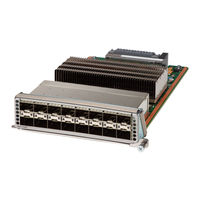HP MDS 9000 Series Cisco Switch Manuals
Manuals and User Guides for HP MDS 9000 Series Cisco Switch. We have 1 HP MDS 9000 Series Cisco Switch manual available for free PDF download: Configuration Manual
HP MDS 9000 Series Configuration Manual (1444 pages)
Cisco MDS 9000 Family CLI Configuration Guide, Release 3.x (OL-16184-01, April 2008)
Table of Contents
-
-
-
-
Getting Help94
-
-
Moving Files113
-
Copying Files114
-
Deleting Files115
-
Command Scripts117
-
Licensing Model124
-
-
Application136
-
Dmm_For_Ssm_Pkg139
-
Enterprise_Pkg139
-
Fm_Server_Pkg139
-
Mainframe_Pkg139
-
Qos_Manager139
-
San_Extn_Over_Ip139
-
-
-
-
About NTP175
-
Configuring NTP176
-
-
-
Configuring CDP192
-
About CFS197
-
-
CFS Features198
-
CFS Protocol199
-
CFS Regions211
-
-
-
-
Quick Upgrade245
-
Default Settings255
-
-
-
-
-
-
-
-
Default Settings293
-
About Modules295
-
-
-
Services Modules297
-
Default Settings325
-
-
-
Reason Codes336
-
-
Autosensing343
-
-
-
About Speed Leds345
-
Buffer Credits360
-
VSAN Interfaces367
-
Default Settings368
-
-
About NPV369
-
NPV Mode372
-
NP Ports373
-
Configuring NPV376
-
Verifying NPV379
-
-
-
-
Buffer Pools388
-
-
-
Port Indexes396
-
Portchannels398
-
Default Settings418
-
About Trunking419
-
-
-
Default Settings425
-
-
-
-
About Domain Ids453
-
Domain Ids453
-
Default Settings468
-
-
-
Defining a Job472
-
Execution Logs477
-
About Vsans483
-
Vsans Topologies483
-
-
-
VSAN Advantages485
-
-
Default Settings494
-
About SDV495
-
-
-
Configuring SDV498
-
Key Concepts498
-
Default Settings508
-
Dpvm509
-
-
-
Enabling DPVM510
-
Default Settings521
-
-
About IVR524
-
IVR Features525
-
IVR Terminology525
-
Ivr Nat527
-
Configuring IVR530
-
Enabling IVR531
-
Enabling IVR NAT536
-
About Afids538
-
-
Default Settings566
-
About Zoning567
-
-
-
Zoning Example568
-
Zone Sets573
-
-
About LUN Zoning587
-
Enhanced Zoning596
-
Default Settings607
-
-
-
-
About FSPF622
-
-
FSPF Routes629
-
Default Settings642
-
Flogi645
-
Fdmi649
-
-
-
Displaying FDMI650
-
Rscn651
-
Default Settings658
-
-
-
About FICON663
-
-
-
FICON Cascading669
-
-
Port Addresses672
-
FC ID Allocation675
-
Port Prohibiting687
-
About RLIR689
-
Port Swapping698
-
Swapping Ports699
-
-
Default Settings711
-
-
About CIM713
-
-
-
-
World Wide Names720
-
Default Settings731
-
FIPS Self-Tests735
-
-
-
VSA Format771
-
About TACACS+773
-
Enabling TACACS+774
-
Default Settings797
-
-
-
SNMP Version 3740
-
-
Default Settings755
-
-
-
-
Port Information801
-
ICMP Information802
-
TOS Information802
-
-
-
-
OCSP Support815
-
-
Maximum Limits847
-
Default Settings848
-
-
-
About Ipsec850
-
About IKE851
-
Using Ipsec852
-
Crypto Ipv4-Acls864
-
-
Default Settings889
-
-
-
Dhchap891
-
-
-
-
Default Settings902
-
-
Auto-Learning909
-
-
Default Settings922
-
-
-
-
Default Settings933
-
About Roles936
-
About Users945
-
-
-
-
About SSH949
-
Default Settings955
-
About FCIP959
-
-
FCIP Concepts960
-
FCIP Links961
-
FCIP Interfaces962
-
FCIP Profiles962
-
-
Fspf963
-
Vrrp964
-
Configuring FCIP965
-
Enabling FCIP966
-
Peer IP Address977
-
FCIP Compression994
-
Default Settings997
-
Data Pattern1001
-
-
-
Configuring Iscsi1012
-
Enabling Iscsi1012
-
Dynamic Mapping1014
-
Static Mapping1015
-
Iscsi Access Control1027
-
Local Authentication1032
-
Iscsi Listener Port1035
-
Iscsi Routing Modes1036
-
-
Configuring Islb1047
-
Locking the Fabric1064
-
CFS Merge Process1065
-
No Authentication1075
-
Isns1087
-
Example Scenario1091
-
Target Discovery1094
-
Isns Cloud Discovery1101
-
Default Settings1104
-
-
Default Gateway1109
-
Ipfc1112
-
Ipv4 Static Routes1116
-
About Overlay Vsans1118
-
Overlay Vsans1118
-
About VRRP1123
-
Configuring VRRP1124
-
Priority Preemption1128
-
Default Settings1135
-
Services Modules1137
-
-
IPS Module Upgrade1139
-
Supported Hardware1140
-
-
About Ipv41151
-
Vlans1155
-
Ipv4-Acls1157
-
ARP Cache1158
-
Clearing ARP Cache1159
-
Displaying ARP Cache1159
-
-
-
Default Settings1160
-
-
-
-
About Ipv61161
-
Ipv6 Address Formats1162
-
Global Addresses1163
-
Link-Local Address1164
-
ICMP for Ipv61166
-
Router Discovery1169
-
Reachability Time1176
-
Retransmission Time1176
-
Default Settings1180
-
-
-
-
SCSI Flow Statistics1187
-
Default Settings1192
-
-
Configuring Santap1200
-
Configuring Nasb1207
-
About Nasb1207
-
-
-
-
About NASB1208
-
Configuring NASB1210
-
Default Settings1212
-
About RMON1215
-
Configuring RMON1215
-
-
-
SPAN Sources1220
-
SPAN Sessions1223
-
Specifying Filters1223
-
Configuring SPAN1224
-
Remote SPAN1235
-
FC and RSPAN Tunnels1236
-
Configuring RSPAN1238
-
Explicit Paths1244
-
Sample Scenarios1246
-
-
-
-
Module Logging1257
-
Log Files1258
-
Log Files1259
-
-
Default Settings1268
-
-
-
Call Home Features1270
-
Cisco Autonotify1270
-
Contact Information1271
-
Destination Profiles1272
-
Alert Groups1275
-
-
Syslog-Based Alerts1278
-
E-Mail Options1279
-
RMON-Based Alerts1279
-
Fabric Lock Override1283
-
Default Settings1288
-
Event Triggers1289
-
Message Contents1292
-
-
-
About FCC1309
-
FCC Process1310
-
Enabling FCC1310
-
About Data Traffic1313
-
Creating a Class Map1315
-
-
Default Settings1322
-
-
About Port Tracking1323
-
-
-
About Port Tracking1325
-
-
Fctrace1333
-
Fcping1335
-
-
GUI-Based Client1338
-
Capture Filters1345
-
Loop Monitoring1346
-
IP Network Simulator1354
-
Default Settings1362
-
-
-
Core and Log Files1369
-
Kernel Core Dumps1374
-
-
Advertisement
Advertisement
